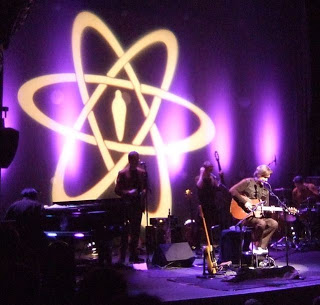"Control" – Anton Corbijn's film on Ian Curtis
Rewind. It’s 1989 and I am in Deansgate, Manchester and I’m standing in the street looking up at the ancient bulk of the John Rylands Library. Grey clouds pass overhead in a grey sky. This library seemed to be the oldest building I had ever seen in my life, although it was only constructed at the end of the 19th century. It just looked very old; all ancient brickwork and tiny bottle-green windows buried in thick sandstone walls. Half church and half library. On my walkman (remember this is 1989) I am listening to a cassette tape of Joy Division’s “Decades”, the last song on their last album. Those long echoey notes reverberating off to infinity and Mr. Curtis mournful voice intoning over and over again “here are the young men … but where have they been, where have they been?”. Hm!
If there was a every a music which is so strongly linked to a time and place for me it would have had to be Joy Division (leading purveyor of what a music journalist once called “undertaker rock”) and Manchester. It was years after I left Manchester (where I lived for three years) before I could listen to any of that music again. In Canada in the soft blue-green light of the not-too distant pacific ocean, or in Marseille with its hard Mediterranean light, lead singer Ian Curtis’ words could not survive, drowned out by the light. I could not imagine this kind of music ever originating in these kinds of places and even to listen to it there seemed wrong.
But I am back in northern latitudes now, although still far from the grey of Manchester. Far enough north to be interested to see photographer Anton Corbijn’s film about Curtis and Joy Division, “Control”, which has just been released here in France. The film follows Curtis from his childhood years in Macclesfield to his suicide in 1980 at the age of 23. The film is shot in a beautiful, slightly saturated silvery black and white, a masterstroke, and each scene is carefully framed with a careful photographers eye: many scenes are almost Antonioninen in their simplicity and cadrage. Cast members actually play their respective instruments during the film (they all learned the songs during months of practice beforehand) and Sam Riley bears and incredible, uncanny resemblance to Curtis.
The film recounts faithfully the story of Curtis’ rapid ascent to fame and his subsequent inability to cope with all the commitments and responsibilities which that entailed. Having married at a very early age, he found himself locked into a relationship he couldn’t escape whilst at the same time he was already seeing another woman, a belgian journalist he’d met at a concert. He saw no way to resolve all this other than by exiting, stage left.
Of course fans know this story in infinite detail. And it is hard to listen to the music without applying the filter of what is to come. It seems in the film that the end comes almost too quickly (as it did in real life I suppose): we only gain a partial insight into Mr. Curtis and his personality and motivation. Some explanations seem straightforward enough; a string of errors leading into an inescapable dead-end. But I felt that somehow early in the film there is only a small hint of what is to come; Curtis doesn’t seem to be nearly the mass of contradictions one would need to be in order to lead one to suicide. In the end the film of his life could never be as suffocating and bleak as the music he helped create, I think (which is probably a good thing), even though the music plays a very important part in the film.
Technorati Tags: Anton Corbijn, Control, Ian Curtis

